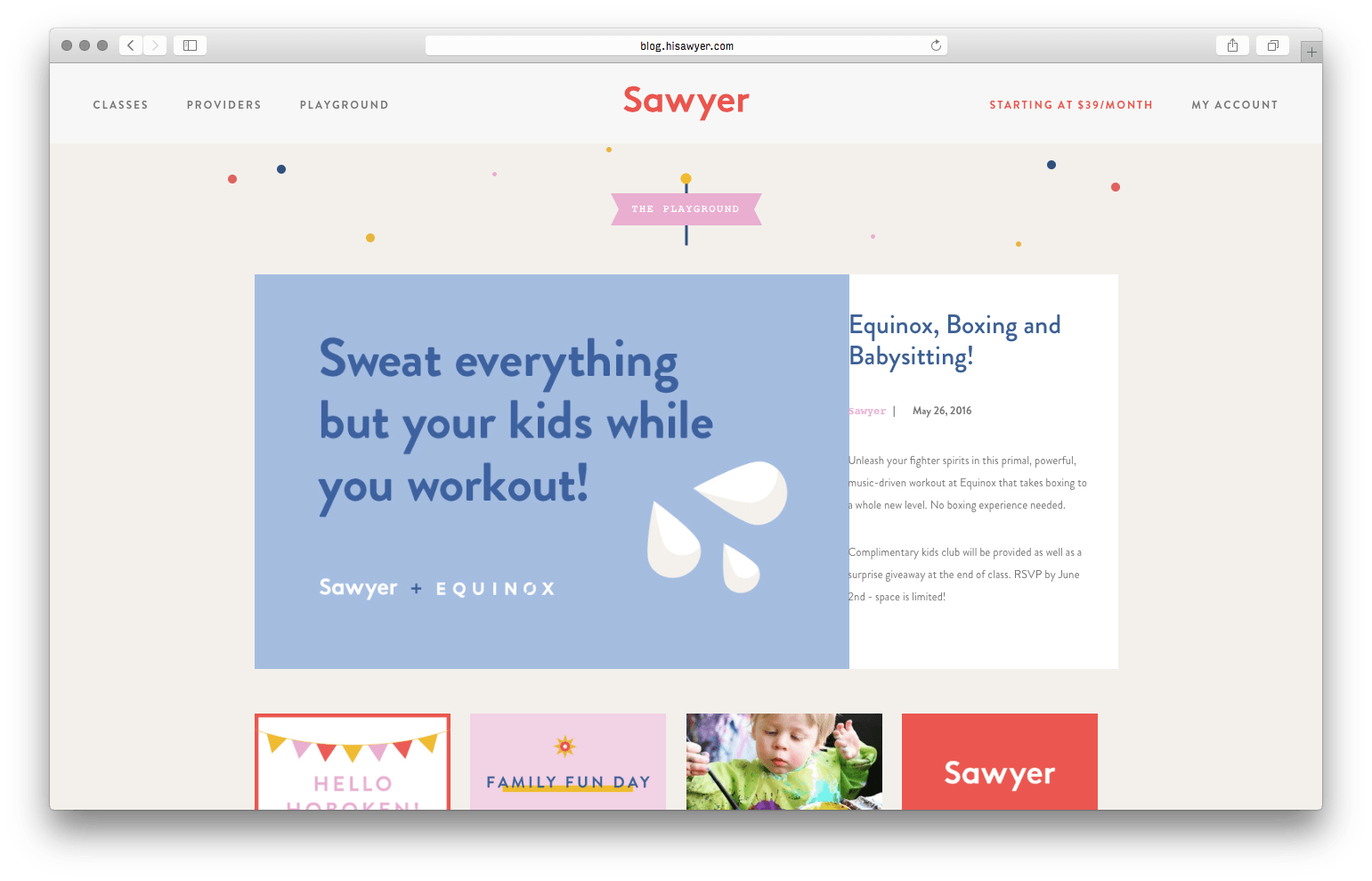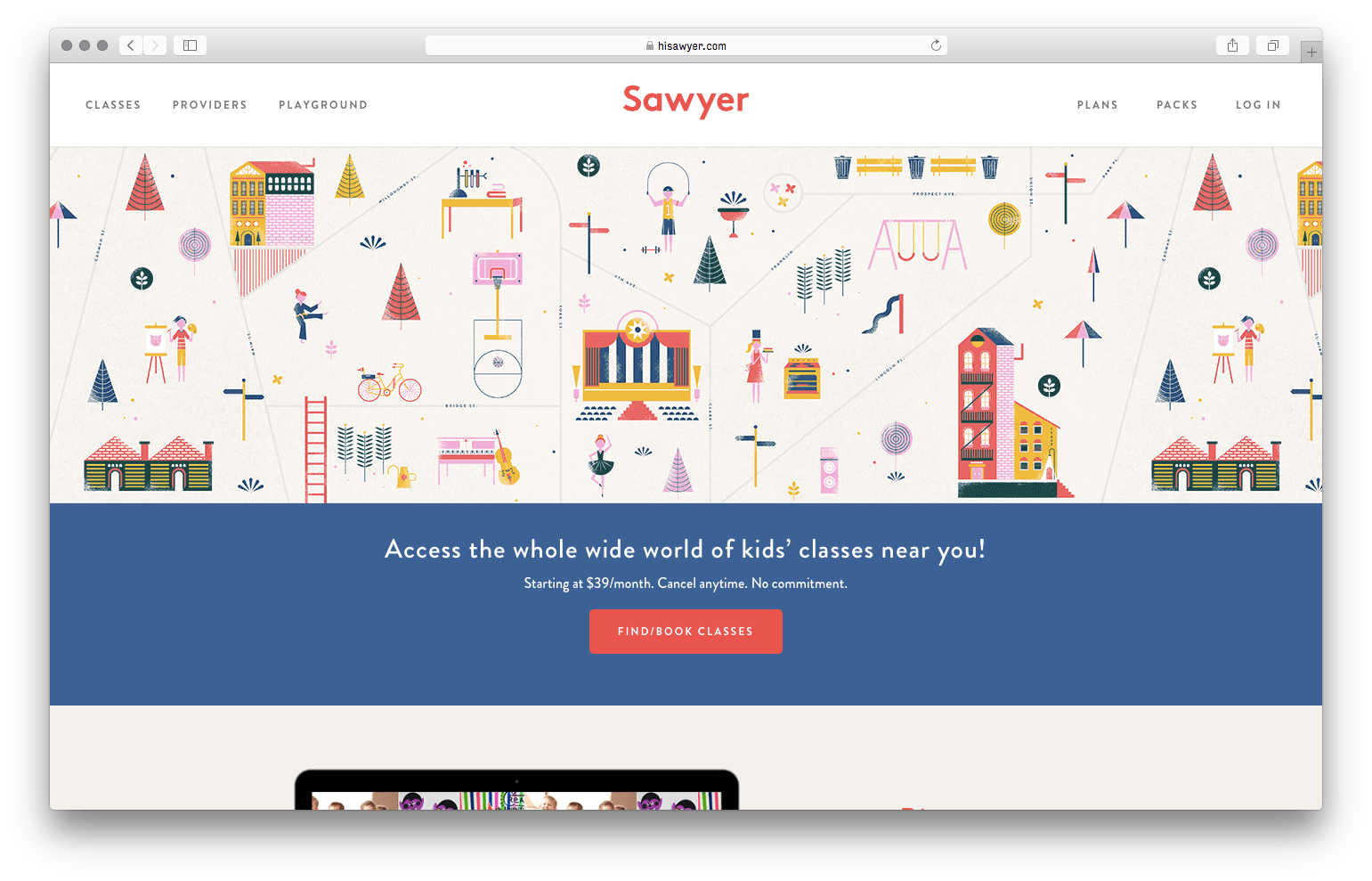Adventuring with Sawyer, One Kids’ Class at a Time
This interview is part of the 10th issue of Featuring, a monthly newsletter on the intersection of business and culture. Sign up.

Marissa Evans Alden was a college student when she started her first company. The thrill of seeing others using her products and building something motivated her, and drew her back to the world of entrepreneurship years later.
The idea for Sawyer came when she met future co-founder Stephanie Choi at Rent the Runway, where they had the idea for a platform that could connect parents with classes for their kids. “We’re a couple of neighbors helping our neighbors,” Evans describes on the site. “Like sharing some eggs or sugar – but in this case, we’re sharing the whole wide world of nearby kids’ classes, plus a way to access them.” Last fall, the founders made the jump to work on Sawyer full-time and haven’t looked back.
We talk to Marissa about how she got her start and how she wants to enable kids and their families to explore their worlds.
How did you get your start as an entrepreneur?
My first company was a t-shirt company I started with my best friend in college, where we sold custom t-shirts to the Greeks on campus. I loved the ownership and seeing people we didn’t know wearing our shirts. I loved knowing we made that happen.
Fast forward to after college: I went to business school, then took a job at Digitas, a digital agency with very structured, corporate environment. I learned a lot over that year and a half, but it didn’t feel right for me.
Meanwhile, New York in 2008 felt like a technology renaissance. All this innovation was happening in the technology scene. Gilt was starting, Foursquare was launching, it was all happening — and I wanted to be a part of it.
I specifically remember reaching out to Noah Glass, founder of Olo at the time, an app where you could text a restaurant to skip the line and pick up your food. We had coffee and I wanted more than anything to be on that side of the table. Being an entrepreneur fit my personality, my interests, and felt like everything I wanted in my career.
How did the idea for Sawyer come about?
I met Stephanie while we were working together at Rent the Runway. We were partnered together professionally, and quickly grew into good friends. She has a 2 ½ year old daughter, Maddie, so would spend a lot of time trying to figure out what classes her daughter should take during the day, and realized there weren’t a lot of tools to figure out what she should take, as well as pay for it all in one place.
That became the inkling of the idea for Sawyer. On the other side of that, there were all these programs and classes with empty seats looking for children to fill them, so we wanted to be the connector. Both of us had experience in building a subscription business and a product, so we were eager to start exploring the space. We quit our jobs last fall to work on it full-time.
What’s your goal for Sawyer?
We say that Sawyer helps children discover the world at large by discovering their own communities. Steph and I want to take the burden off of parents and providers, and make it easy to find great classes in their neighborhood.
Six months in, what have been some of the early challenges?
When you start something from scratch, so much of your job is selling the vision. There’s this hurdle of the unknown for our partners and customers, so you’re explaining your product, how it works, and trying to convince them to try something new.
Much of your job is to be that zealot cheerleading the idea. Your external persona has to be that salesman, but you’re also building the product and engrossed in the numbers and customer feedback. This is a delicate balance.
Do you think that there’s a certain personality type that lends itself to that role?
Multiple people tell me that I remind them of the character, Kimmy, from The Unbreakable Kimmy Schmidt. I think that eternal optimism helps because there are a lot of low points. I can try to channel Kimmy in my days where I get super frustrated. Internalizing it, but then doing something else, like getting back to work or going for a run.
 The Unbreakable Kimmy Schmidt in action.
The Unbreakable Kimmy Schmidt in action.
Did you always know that you wanted a co-founder?
With my second company, Go Try It On, I was the sole founder. From that, I learned that if I was going to do this again, I definitely wanted a co-founder. That’s been the most significant difference in this company. Having Steph has made this a million times easier and a million times more fun — it’s the best thing in the world.
The hard stuff is less hard because I can go to her and talk it through, and the good stuff is so much more fun because it doubles the excitement. It’s the best thing I think you can do, assuming you find the right person. Because Steph and I have worked together for so long, we know how each other works.
What advice would you give to someone looking for a co-founder?
Someone once gave me the advice that you should find a co-founder that balances the gaps in your own resume. You should look for someone who has fortés in the areas you feel nervous or anxious about.
Working with someone for a while is a really good indicator. If you think about your own network and people in your life that you have worked well with; this is a good way to source a co-founder.
Where do you see Sawyer going in the next few years?
The last couple months have taught us how much more there is to be done. A lot of the providers we work with — ballet studios, yoga studios, music classes, math courses — don’t use technology to power their businesses, so we’re building them this really cool software to help them power their own scheduling, then building Sawyer into that process.
We have some new product features coming up. Right now, Sawyer operates like a passport, offering either a subscription model or the ability for classes to be bought in packs. That idea will always be a part of the system, but in listening to what our customers want, we hear that they want solutions to booking summer camps, birthday parties, and so much more.
 Follow Sawyer’s blog for upcoming events and features.
Follow Sawyer’s blog for upcoming events and features.
How do you evaluate what features or ideas to pursue?
Prioritization is always tough in a startup. You don’t have a ton of hands or resources, so you have to be critical about what projects or features you pursue. Listening to our customers and hearing their feedback has hugely influenced our development, even from an early stage.
With our beta launch, we wanted to get a minimum viable product out the door and, for us, that was a scheduler that allowed you to book classes for one child. When we asked our customers for feedback, we found that many of these users had two, three kids and needed something that could let them book classes for all of them. It made it pretty clear what our next feature should be.
Any advice for young entrepreneurs?
I remember the moment where I was still working on my job, and was debating quitting to pursue Sawyer. I knew that ten years from now, I would want to know that I tried this, and tried to make it happen. Put on your ten-years-from-now hat and try to think about what you would want for yourself, then go for it.
